As we drive towards Leadville, I am convinced that we have been there previously. I have a very clear mind picture of what the town looks like. Sterling has no recall of it but I assure him he’ll remember the minute we arrive. He has the last laugh: wherever I’m thinking of, it’s not Leadville but given the fantastic location, cutsie town center and passable brew pub, it’s hard to believe that we haven’t been here before.
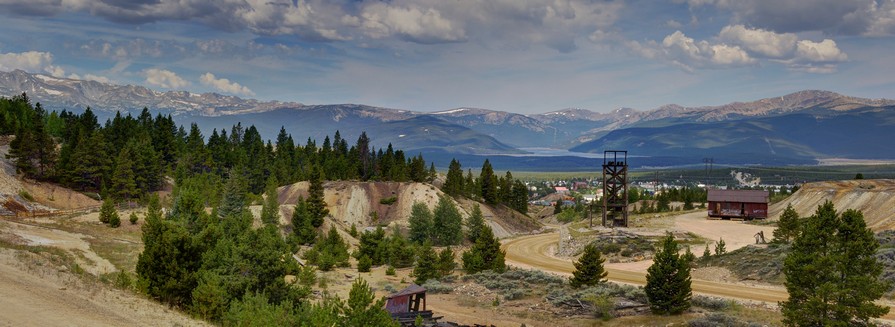 Leadville, Colorado lays claim to the title of highest incorporated city in the USA at 10,152 feet. With a population of 2,580 (2013) it’s easy to see that it’s not present day size that matters here so much as previous economic dominance: at it’s height the community is estimated to have been anywhere between thirty and sixty thousand. It was second city to Denver and the source of the immense wealth that financed the development of the capital city. Gold in them there hills, followed by silver, zinc, lead, copper and finally molybdenum made Leadville one of the most diverse mining settings imaginable, attracting people with the promise of a quick buck and at times creating one of the most lawless towns in the state.
Leadville, Colorado lays claim to the title of highest incorporated city in the USA at 10,152 feet. With a population of 2,580 (2013) it’s easy to see that it’s not present day size that matters here so much as previous economic dominance: at it’s height the community is estimated to have been anywhere between thirty and sixty thousand. It was second city to Denver and the source of the immense wealth that financed the development of the capital city. Gold in them there hills, followed by silver, zinc, lead, copper and finally molybdenum made Leadville one of the most diverse mining settings imaginable, attracting people with the promise of a quick buck and at times creating one of the most lawless towns in the state.
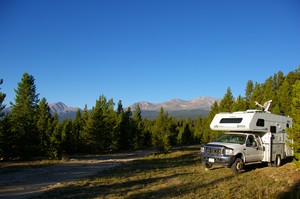 All of that is a far cry from today. Sitting among the high peaks of the Rockies, the town’s stunning location is the first thing to make an impression. Mount Elbert, the second highest peak in the contiguous US forms part of the range of mountains that surrounds the wide open valley in which the town nestles. Just along from Elbert sits another giant, Mount Massive, the third highest peak in the lower forty eight and from where we’re camped a few miles out of town, we have a clear view of them both.
All of that is a far cry from today. Sitting among the high peaks of the Rockies, the town’s stunning location is the first thing to make an impression. Mount Elbert, the second highest peak in the contiguous US forms part of the range of mountains that surrounds the wide open valley in which the town nestles. Just along from Elbert sits another giant, Mount Massive, the third highest peak in the lower forty eight and from where we’re camped a few miles out of town, we have a clear view of them both.
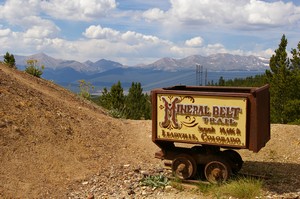 Today, the main business is tourism. Much has been done to clean up the toxic waste left by the mining heyday and old railways have been transformed into the Mineral Belt Trail, circling the town on it’s twelve mile route. It’s a wonderful paved cycling path with stunning views of the surrounding mountains and interest closer to hand in the old mines, workings and slag heaps. A short but extremely pleasurable ride with interpretive boards along the way.
Today, the main business is tourism. Much has been done to clean up the toxic waste left by the mining heyday and old railways have been transformed into the Mineral Belt Trail, circling the town on it’s twelve mile route. It’s a wonderful paved cycling path with stunning views of the surrounding mountains and interest closer to hand in the old mines, workings and slag heaps. A short but extremely pleasurable ride with interpretive boards along the way.
Back in town, the view from Safeway is making me consider developing a rating scale for towns, based on the view from their supermarket check-out queue. Most have none, at most a singularly uninspiring wall or maybe a glimpse of the car park. Leadville is not one of these. The tills are positioned in front of a wall of windows. I’m not sure why, but it’s a little surreal looking up from the trolley to see such wonderful scenery. I think we may have to add this to the criteria on which we assess towns as potential future places to settle.
 We’re always keen to visit a new NPS site and Florissant Fossil Beds National Monument is not that far away. While dinosaurs may immediately come to mind with the mention of fossils, the main attractions here are the much rarer insect fossils. At the Fossil Learning Lab, housed in a yurt, we peer into the microscopes to see tiny insects, seeds and leaves captured in time.
We’re always keen to visit a new NPS site and Florissant Fossil Beds National Monument is not that far away. While dinosaurs may immediately come to mind with the mention of fossils, the main attractions here are the much rarer insect fossils. At the Fossil Learning Lab, housed in a yurt, we peer into the microscopes to see tiny insects, seeds and leaves captured in time.
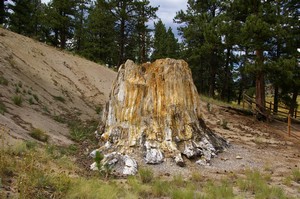 Out on the Petrified Forest Loop, the fossilised remains of redwood stumps stand at the other end of the size scale. While the archaeologist’s practice of backfilling has been employed to protect many remaining specimens, a few have been left above ground. The fact that any of them survived the fossil collecting frenzy of the 1900’s is something of an amazement. The Big Stump still has two rusted sawblades stuck in it: a memorial to the attempts to cut it into removable and presumably saleable pieces.
Out on the Petrified Forest Loop, the fossilised remains of redwood stumps stand at the other end of the size scale. While the archaeologist’s practice of backfilling has been employed to protect many remaining specimens, a few have been left above ground. The fact that any of them survived the fossil collecting frenzy of the 1900’s is something of an amazement. The Big Stump still has two rusted sawblades stuck in it: a memorial to the attempts to cut it into removable and presumably saleable pieces.
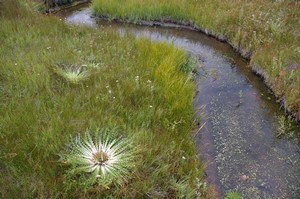 Elsewhere in the Monument, the Hornbek Wildlife Loop is a little disappointing on the wildlife front. We do see some evidence of elk in the form of poo (scat as the scientific types like to call it) but that’s about it. It’s far more interesting on the plant front. This huge thistle defies my attempts to identify it until I read that the Meadow or Elk thistle has two growth habits, one of which produces this huge rosette of leaves with a cluster of stemless flowering heads. It is the only thistle that can be acaulescent - now there’s a new word for your lexicon!
Elsewhere in the Monument, the Hornbek Wildlife Loop is a little disappointing on the wildlife front. We do see some evidence of elk in the form of poo (scat as the scientific types like to call it) but that’s about it. It’s far more interesting on the plant front. This huge thistle defies my attempts to identify it until I read that the Meadow or Elk thistle has two growth habits, one of which produces this huge rosette of leaves with a cluster of stemless flowering heads. It is the only thistle that can be acaulescent - now there’s a new word for your lexicon!
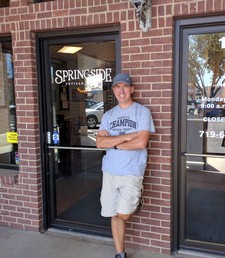 From Florissant we’re heading for Pueblo and the promise of cheese. Sterling’s grandmother, Edna, used to live in Spruce, WI. Any visit to the farm to see her involved an obligatory stop at a small family run cheese factory called Springside. While we often bought a variety of cheeses we always aimed to purchase fresh curds, made that day, and young cheese for making grilled cheese snadwiches. A couple of years ago, Sterling discovered that Springside had opened a retail shop in Pueblo and has been determined to visit. As always on these occasions, we buy more cheese than a family of six can reasonably eat in a fortnight. We also discover that there are plans for the Colorado based Springside Cheesemongers to become cheesemakers. We’ll be returning.
From Florissant we’re heading for Pueblo and the promise of cheese. Sterling’s grandmother, Edna, used to live in Spruce, WI. Any visit to the farm to see her involved an obligatory stop at a small family run cheese factory called Springside. While we often bought a variety of cheeses we always aimed to purchase fresh curds, made that day, and young cheese for making grilled cheese snadwiches. A couple of years ago, Sterling discovered that Springside had opened a retail shop in Pueblo and has been determined to visit. As always on these occasions, we buy more cheese than a family of six can reasonably eat in a fortnight. We also discover that there are plans for the Colorado based Springside Cheesemongers to become cheesemakers. We’ll be returning.
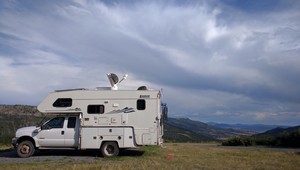 Our next destination is one we both agree we have been to before, Sugarite Canyon State Park. However, upon arrival we cannot remember it. We had discussed our memories of the campground we stayed in and given they were remarkably similar we were confident that we’d recognise it immediately. It takes us two days to realise that the park have created a new campground and that’s where we are: our recall is of the older one down in the valley bottom.
Our next destination is one we both agree we have been to before, Sugarite Canyon State Park. However, upon arrival we cannot remember it. We had discussed our memories of the campground we stayed in and given they were remarkably similar we were confident that we’d recognise it immediately. It takes us two days to realise that the park have created a new campground and that’s where we are: our recall is of the older one down in the valley bottom.
We’re saying farewell to Colorado for now and heading into New Mexico feeling extremely pleased with ourselves: we have managed to get reservations to tour the Folsom Man Archaeological Site on one of the two days of the year when it’s possible. Lunch is being served for participants at the Folsom Museum and in all innocence, we’re looking forward to it. Our first misgivings arise from the building itself but stepping inside is the real stunner. It’s like going into a very well organised indoor garage sale. It is not, in any sense that I understand the word, a museum. It’s a collection of tack (the British meaning), the climax of which is a display of 23 miniature plastic bison on a sheet of green paper. A comment about them is met with keen assurance that this particular display will be changing next year. Another visitor enquires whether excavation is taking place that might lead to further bison being discovered. But no, a jigsaw box is produced: the completed puzzle will form the new base for the herd in 2017. The unused bison sit in a box by the till, 25 cents each. It eventually emerges that the heavy rains of the last few days have made the site inaccessible and the tour will be replaced by a question and answer session in the museum. We leave.
 Not wanting to waste the day we head for Capulin Volcano National Monument, another place I’m convinced we’ve visited and Sterling is not. Guess he’s on a winning streak: I’ve never seen the place in my life.
Not wanting to waste the day we head for Capulin Volcano National Monument, another place I’m convinced we’ve visited and Sterling is not. Guess he’s on a winning streak: I’ve never seen the place in my life.
Capulin sits within the Raton-Clayton Volcanic Field and from up on the rim trail evidence of volcanicity abounds: cones, shield volcanoes, lava flows and pressure ridges pepper the terrain. It’s a surprisingly gentle and beautiful landscape that time has transformed, cloaking the bare volcanic rock in a thick vegetation, the views stretching far into the distance, with five states visible in clear conditions.
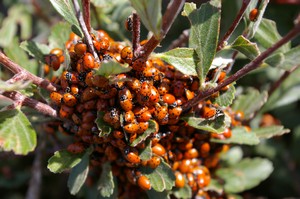 There’s a real surprise here: ladybirds or ladybugs as Sterling knows them. Every year, they arrive on a wind-borne migration and settle on the higher slopes of Capulin where they feed. As the cool weather approaches they begin to hibernate. Those that survive the winter employ the same hitch-hiking trick on a warm wind, come February and head south to breed. As you can see, they are here in their multitudes, great big clumps of them clustered around plants and even rocks. Amazing!
There’s a real surprise here: ladybirds or ladybugs as Sterling knows them. Every year, they arrive on a wind-borne migration and settle on the higher slopes of Capulin where they feed. As the cool weather approaches they begin to hibernate. Those that survive the winter employ the same hitch-hiking trick on a warm wind, come February and head south to breed. As you can see, they are here in their multitudes, great big clumps of them clustered around plants and even rocks. Amazing!
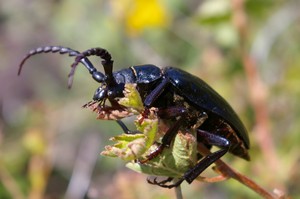 Down in the crater we find a beetle of slightly different proportions: a longhorn. There’s only one of them but it more than makes up for this in sheer size.
Down in the crater we find a beetle of slightly different proportions: a longhorn. There’s only one of them but it more than makes up for this in sheer size.
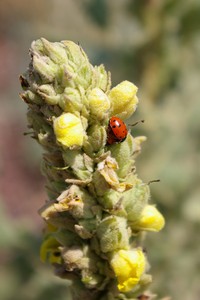 The Common Mullein is an invasive weed that the park service do battle with in an attempt to eradicate or at least control. It was introduced to the US by early European settlers for both its medicinal and fish poisoning properties. When the ground up seeds are put in water, they leach a chemical causing fish difficulty in breathing. The fish eventually float to the surface and can be easily caught, the chemical apparently causing no harm to humans. I guess the ladybirds aren’t too keen on it.
The Common Mullein is an invasive weed that the park service do battle with in an attempt to eradicate or at least control. It was introduced to the US by early European settlers for both its medicinal and fish poisoning properties. When the ground up seeds are put in water, they leach a chemical causing fish difficulty in breathing. The fish eventually float to the surface and can be easily caught, the chemical apparently causing no harm to humans. I guess the ladybirds aren’t too keen on it.
We leave this monument heading for another, Aztec Ruins. We’re due there in a few days for a very special event: my citizenship ceremony in the Great Kiva.